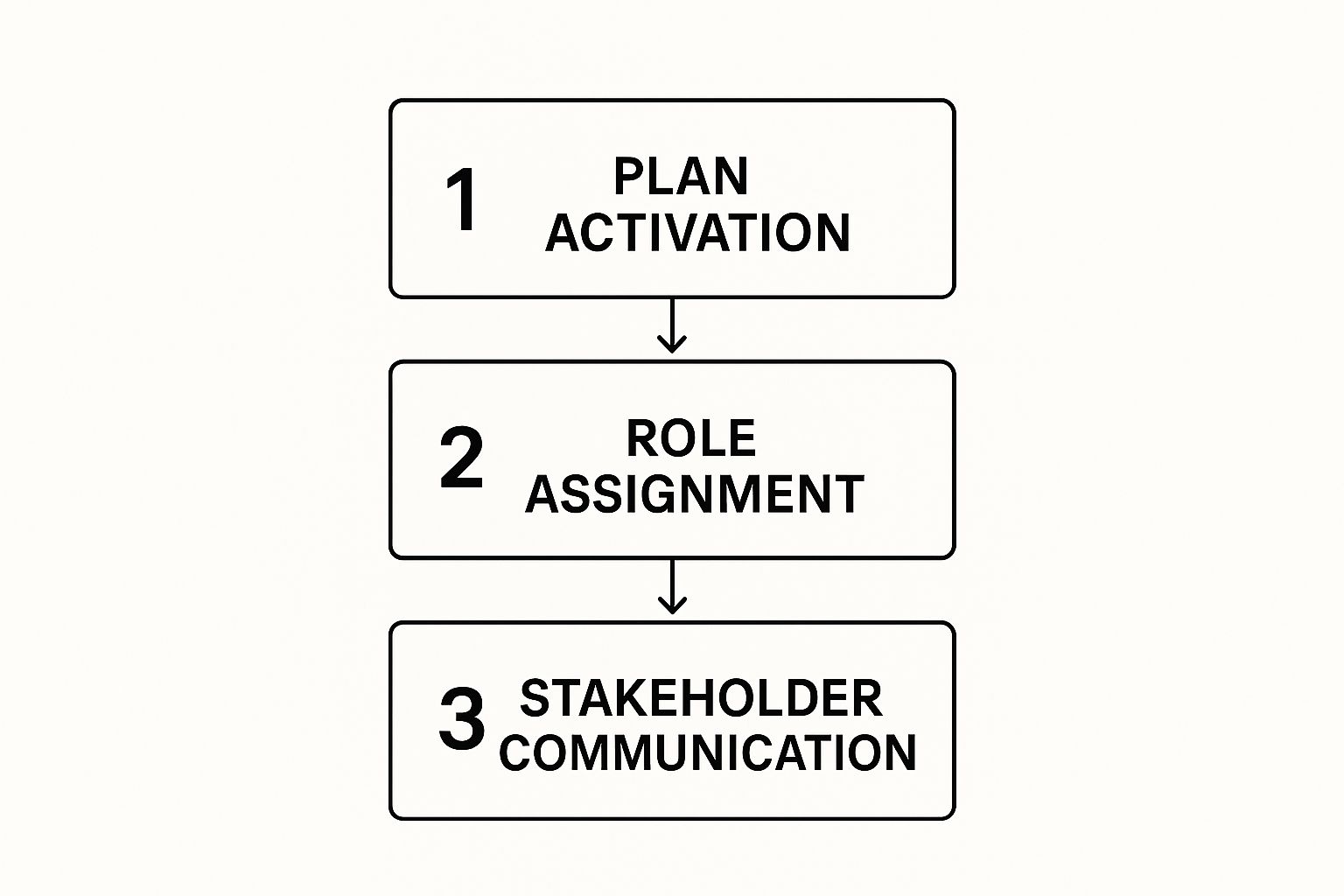A crisis communication plan template is your business's ultimate playbook for dealing with unexpected trouble quickly and effectively. Think of it as your strategic guide, laying out exactly who does what, what to say, and how to act to protect your brand’s reputation and keep stakeholders in your corner when things go south.
Why Your Business Needs a Plan Before a Crisis Hits

It's a shocking figure, but the hard truth is most businesses are just winging it when it comes to sudden disruptions. A 2023 Capterra study revealed that only 49% of U.S. companies had a formal crisis communication plan. This isn't just a missing piece of paper; it's a massive, gaping hole in your company's armor.
Having a plan isn’t about ticking a box and filing a document away. It’s about building a strategic shield for your brand’s reputation, customer loyalty, and ultimately, your bottom line. Without one, you're left scrambling in the dark, a surefire recipe for a chaotic, inconsistent, and damaging public response.
The Real Cost of Being Unprepared
Overconfidence is a killer. So is simply not knowing where to even start. But when a crisis strikes, every single second counts. A fumbled or delayed response can quickly spiral a manageable issue into a full-blown catastrophe that you can no longer control.
The first 24 hours of a crisis often determine how your organization's response will be remembered for years to come. A solid plan ensures quick, consistent, and transparent communication, which is why a staggering 84% of leaders who've been through a crisis say they would increase practice drills afterward.
This is precisely where a crisis communication plan template becomes one of the most valuable assets your business can have. It gives you a clear, actionable roadmap, turning potential chaos into a structured and controlled response. It's less of a rigid script and more of a flexible framework that empowers your team to act decisively under intense pressure. The core idea is the same as having a great company emergency action plan—proactive planning is what gets you through an incident effectively.
What Actually Makes a Plan Effective?
A truly effective plan is way more than just a list of emergency contacts. It’s a living, breathing strategy with several core components designed to work together seamlessly when the pressure is on. This approach isn't just for big corporations; a well-structured school crisis communication plan follows the same critical principles of preparedness.
To give you a clearer picture, we've broken down the essential elements that form the backbone of any robust crisis plan.
Core Components of an Effective Crisis Plan
This table outlines the foundational pieces of a crisis communication plan that you can adapt for your own organization.
Having these core elements defined and ready to go is what separates a controlled, professional response from a panicked, disorganized one. They provide the structure needed to navigate the storm with confidence.
A great plan is powerless without the right people to execute it. When a crisis hits, you don't have time to figure out who's in charge or start assigning tasks. That's a recipe for chaos.
Assembling your crisis communication team isn't just about filling slots on an org chart. It’s about handing specific, real-world responsibilities to individuals who can act decisively under immense pressure. By pre-assigning these roles and creating a clear chain of command, you eliminate the hesitation that can cripple your initial response. Every person needs to know exactly what they’re responsible for, who they report to, and how their piece fits into the bigger picture.
Defining Core Roles and Responsibilities
While the size of your team will depend on your organization's scale, a few key roles are non-negotiable. These positions form the backbone of your response structure, ensuring all critical functions are covered from the second a crisis is identified.
- Crisis Lead/Manager: Think of this person as the quarterback. They oversee the entire operation, make the tough strategic calls, and ensure every part of the plan is actually happening. They don't have to be the CEO, but they absolutely must have the authority to get things done.
- Designated Spokesperson(s): This is the public face and voice of your company. A great spokesperson has to be credible, calm under fire, and deeply trained in media relations. You might even need more than one—a technical expert for a product recall and a C-level executive for a major reputational crisis.
- Internal Communications Coordinator: This role is critical but often overlooked. This person is responsible for keeping your own people in the loop. They draft and send updates to all employees, making sure your team hears the news from you first, not from a frantic social media scroll.
- External Communications Coordinator: This individual handles every message that goes outside the company. They're the ones drafting press releases, updating the website, and crafting customer emails, all while working hand-in-glove with the spokesperson to keep the message consistent.
- Social Media Monitor/Manager: In our world, this is an essential front-line role. This person lives on your social channels, actively monitoring for mentions, tracking sentiment, and sniffing out misinformation. They’re also responsible for pushing out approved company updates across all platforms.
Creating a Clear Chain of Command
Confusion is the enemy during a crisis. A straightforward chain of command is your best weapon against it, ensuring decisions are made efficiently and communication flows without getting stuck in a bottleneck. Think of it like a simple phone tree—everyone knows who to call and who has the final say.
Your chain of command should be simple enough to sketch on a napkin. If it takes a complex flowchart to explain who approves a tweet, it’s too complicated and will break under pressure.
Here’s a real-world example: A social media monitor spots a sudden spike in negative comments about a service outage. They immediately ping the External Communications Coordinator, who flags it for the Crisis Lead. The Crisis Lead decides a public statement is needed and tasks the team with drafting one. That draft then goes to the legal team and CEO for final sign-off before the spokesperson ever steps in front of a camera. This streamlined flow prevents chaos and guarantees a unified, calm response.
How to Identify Your Biggest Crisis Risks

You can't really build a solid crisis communication plan for threats you haven't even considered. A proactive risk assessment is the bedrock of any plan that actually works, helping you see potential disruptions coming before they hit.
This isn’t about trying to predict the future with a crystal ball. It’s about making an educated guess so you aren’t caught completely flat-footed when something goes wrong.
Start by getting your team in a room and brainstorming every conceivable crisis that could sideswipe your business. Think beyond the obvious stuff. The goal is to create a list that’s tailored to your specific industry, your day-to-day operations, and even your geographic location.
Brainstorming Potential Scenarios
To get the ball rolling, it helps to think in categories. This organizes your brainstorm and makes sure you don’t miss an entire class of risks.
Here are a few common risk categories to kickstart your session:
- Operational Risks: These are the threats tied directly to your daily business functions. Think supply chain meltdowns, a major piece of equipment failing, or a critical software outage that grinds your services to a halt.
- Reputational Risks: This bucket holds anything that could tarnish your public image. We’re talking about negative press, a social media scandal blowing up around an employee, or customer backlash from a new policy change.
- Personnel Risks: Sometimes, the crisis comes from inside the house. This could be the sudden departure of a key executive, widespread employee misconduct, or a serious workplace safety incident. Our guide to OSHA first aid requirements can help you get ahead of the safety aspect here.
- External Risks: These are the big-picture factors that are largely outside your control. Natural disasters like floods or hurricanes, a sudden economic downturn, or sweeping industry-wide regulatory changes all fall under this umbrella.
A major trend we're seeing globally is the rise of extreme weather events as the number one reason companies are activating their crisis plans. A 2024 report found these events triggered 48.3% of all activations, showing just how much climate change is shaping corporate risk. You can read more about those findings on thebci.org.
Prioritizing Risks by Likelihood and Impact
Once you have a big list, you need to get real. You can't prepare for everything equally. The next move is to prioritize, and a simple risk matrix is your best friend here.
For each potential crisis on your list, you'll assess two key factors:
- Likelihood: How probable is it that this will actually happen? Give it a rating—low, medium, or high.
- Impact: If this did happen, how bad would it be? Think about the financial, reputational, and operational damage.
A low-likelihood, high-impact event (like a data breach for a small retailer) might still need more attention than a high-likelihood, low-impact one (like a temporary Wi-Fi outage). The whole point is to focus your energy on the threats that can do the most damage.
For example, a restaurant absolutely has to prioritize food safety issues (high impact) over a single negative Yelp review (lower impact). On the other hand, a software company needs to be far more worried about server outages (high impact) than it does about typical employee turnover.
This practical approach ensures your crisis plan is built to handle your most realistic and damaging threats first.
Choosing Your Communication Channels and Tech

When a crisis hits, how you say something can be just as critical as what you say. A huge part of your crisis communication plan template involves picking the right channels and technology to get your message out. The real goal here is to match the delivery method to both your audience and the urgency of the moment.
Think about it: an internal IT meltdown requires a completely different approach than a public safety incident. For internal hiccups, platforms like Slack, Microsoft Teams, or a straightforward company-wide email usually do the trick. They’re quick, direct, and keep your team in the loop without causing a public panic.
But when a crisis impacts your customers, the public, or your investors, you need a much broader toolkit.
Building Your Modern Communication Stack
Your company website needs to be your "single source of truth." This is where you'll host a dedicated crisis or news page with detailed updates, official statements, and answers to common questions.
At the same time, social media platforms like X (formerly Twitter), LinkedIn, and Facebook are non-negotiable for pushing out rapid, real-time updates and stamping out misinformation before it spreads. And yes, traditional press releases are still essential for getting your official statement on the record with media outlets.
Mass notification systems are another powerful tool in your arsenal. They let you send targeted SMS texts or emails to specific groups of stakeholders almost instantly.
The secret sauce is making sure it all works together. Technology has come a long way, but a lot of emergency communication tools haven't kept up. In fact, frustration with outdated tech is a growing problem. Dissatisfaction with emergency communication tools jumped to 20.3% in 2024, with poor integration (48.3%) being the biggest complaint. You can discover more insights about this communication report on cerkl.com.
Don't let clunky technology become a second crisis. The best tech stack is one that’s reliable, integrated, and simple enough for your team to use under extreme pressure without any hesitation.
Matching the Channel to the Crisis
Think of your communication channels like tools in a toolbox. You wouldn't grab a hammer when you need a screwdriver. The same logic applies here.
Let's walk through a few practical scenarios:
- Internal IT Outage: Your best bet is to use Slack or email for immediate, company-wide alerts. It's fast, contained, and gets the word out to the right people without a lot of noise.
- Product Recall: This demands a full-court press. You'll need to use mass email and SMS for direct customer outreach, post a can't-miss banner on your website, push updates across all social media channels, and issue a formal press release.
- Workplace Safety Incident: An emergency action plan template, like the one found here, will guide your first moves. On the communication front, this means instant internal notifications to keep employees safe, followed by carefully worded external statements for the media and public once you have all the facts straight.
Ultimately, your plan must clearly spell out which channels to use for specific scenarios and audiences. This eliminates guesswork when every second is critical and ensures your message lands with the right people, right away.
Drafting Key Messages Before You Need Them
When a crisis hits, you don't have the luxury of time to workshop statements from scratch. The pressure is on, and every second you spend agonizing over words is a second you've lost control of the narrative. This is exactly why a core part of any solid crisis communication plan template is doing the heavy lifting before you need it by pre-drafting your communications.
Think of these as fill-in-the-blank holding statements for various potential scenarios. They’re designed to be deployed in that critical first hour, providing a solid, empathetic foundation that ensures your initial response is both immediate and thoughtful.
The Anatomy of a Strong Crisis Message
Every initial statement needs to hit a few key notes. Your pre-drafted templates should have clear placeholders for these elements so nothing gets missed when the heat is on.
- Acknowledge the situation: State simply and clearly that you are aware of what's happened. Never speculate or offer details you can't confirm.
- Express empathy: Show genuine concern for anyone affected. A human touch is absolutely critical for maintaining public trust.
- Outline immediate actions: Briefly explain what your organization is doing right now to manage the situation.
- Commit to transparency: Promise to share more information as it becomes available and point people to your official channels (like your website or a specific social media account) for updates.
This process flow shows how these high-level steps connect, from activating your plan to getting your message out the door.

As you can see, activating the plan immediately triggers role assignments, which is what allows for organized, swift communication with your stakeholders.
Before you start writing, it helps to have a checklist handy. A quick review against this list can prevent common mistakes and ensure your message lands the right way.
Message Crafting Checklist
This table is a quick-reference checklist to ensure your crisis communications are effective, empathetic, and clear.
Running your drafts through this checklist helps refine them into powerful, trustworthy communications that can be adapted in minutes.
Streamlining the Approval Process
Having pre-drafted messages is a great start, but it's only half the battle. If your statements get stuck in a review bottleneck with legal, marketing, and the C-suite, they're useless. A lean, fast approval process is non-negotiable.
Your approval chain should be as short as humanly possible. The goal for initial holding statements is one primary approver (your designated Crisis Lead) and one backup. Adding too many layers invites debate and delay when speed is your greatest asset.
Document this workflow clearly. Who has the final say on a press release? Who can approve a social media update? Answering these questions now means your team can speak with a single, unified voice when it matters most. This is how you shift from a reactive scramble to a position of control.
Testing Your Plan With Realistic Drills
A crisis communication plan sitting in a binder is almost guaranteed to fail when you actually need it. Think of it like a fire extinguisher you’ve never learned how to use. The only way to build real confidence and competence in your team is to put your plan to the test with realistic, hands-on practice drills.
This is how you transform a static document into a living, breathing strategy your team knows by heart. You're building muscle memory so that when a real crisis hits, the response is swift and coordinated—not hesitant and chaotic.
The goal isn't just to check a box on a preparedness list. It's about finding the hidden weaknesses in a safe, low-stakes environment before they can cause real damage.
Simulating Real-World Scenarios
The most effective drills I’ve seen are tabletop exercises. This is where your crisis team gathers in a room and walks through a simulated event, step-by-step. You don't need fancy software—just a well-thought-out scenario, like a sudden product recall or a damaging rumor blowing up on social media.
As you role-play the situation, you get to test every moving part of your plan:
- Activation: How fast can the team actually be assembled and alerted? Are the right people getting the message?
- Decision-Making: Does the chain of command work smoothly, or do approvals get stuck in a bottleneck?
- Messaging: Can you adapt your pre-drafted statements effectively under pressure, or do they fall flat?
- Channel Reliability: Do your mass notification systems and social media tools actually reach everyone they're supposed to?
These drills almost always reveal surprising gaps. One of the biggest challenges is simply the human element. Research shows that while 70% of plan activations meet the expected response levels, a primary cause of failure is key personnel not responding to the initial alert. You can read more about these findings at thebci.org.
A drill that goes perfectly might feel good, but a drill that exposes a flaw is infinitely more valuable. Finding out your spokesperson freezes under pressure or that your secondary contact list is outdated during a simulation is a gift.
By testing your plan, you're not just rehearsing a procedure; you're stress-testing your entire response ecosystem. This proactive approach is a cornerstone of any effective readiness strategy, much like what's detailed in a solid emergency preparedness checklist. It’s what ensures your team can act with confidence and clarity when it truly counts.
Frequently Asked Questions
Even the most thorough crisis communication plan can leave you with a few lingering questions. That's perfectly normal. Getting those questions answered helps lock in the key concepts and makes sure your final strategy is as practical as it is complete.
Let's dive into some of the most common queries we hear from businesses.
How Often Should We Update Our Crisis Plan?
Think of your crisis communication plan as a living document, not something you write once and file away forever. A good rule of thumb is to give it a full review and update at least once a year.
That said, you’ll also need to dust it off anytime your organization goes through a major change. This could be anything from new leadership coming on board, a major product launch, or even opening a new office. And it's absolutely critical to update the plan after any drill or real-world incident to build in the lessons you just learned.
What Is the Biggest Mistake in Crisis Communication?
Hands down, the single most damaging mistake is waiting too long to communicate. When you stay silent, you create a vacuum. That space will get filled—fast—with rumors, speculation, and flat-out misinformation from everyone else.
This immediately forces your organization onto the back foot, making it infinitely harder to get control of the story.
A very close second is failing to show any empathy. Even when you don't have all the answers, simply acknowledging the situation and expressing genuine concern for those affected is vital for keeping public trust.
Can a Small Business Use This Type of Template?
Absolutely. The core ideas behind solid crisis communication don't change whether you have two employees or two thousand. A small business definitely needs a crisis plan, but it should be scaled to fit your reality.
- Your "crisis team" might just be you and one other key employee.
- Your main communication channels could simply be your customer email list and your Facebook page.
- Your risk assessment will zero in on threats that are specific to your smaller operation.
The fundamentals—knowing your risks, assigning roles, prepping messages, and identifying your channels—are essential for businesses of any size. For more answers to common preparedness questions, you can always explore our general FAQs for additional insights.
At Ready Response, we believe that preparedness is the key to confident action. While this guide helps you manage communication, our hands-on training equips your team with the lifesaving skills needed to respond effectively during any medical emergency. Learn more about our on-site and public courses at https://readyresponsepa.com.
